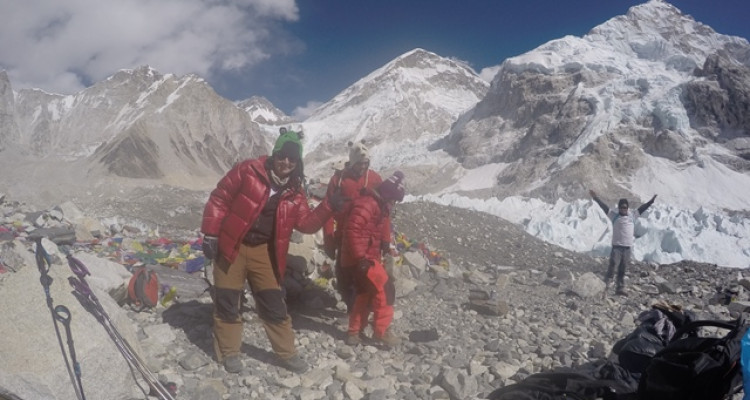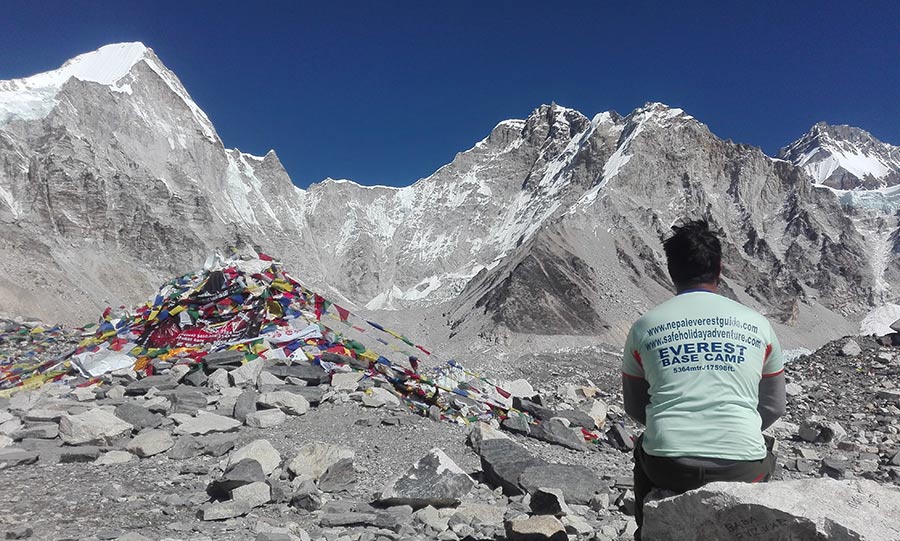April 20, 2023

To successfully complete the Everest Base Camp trek, one needs to be physically prepared to face the challenges of the trail. The trek requires a good level of fitness, stamina, and strength, which can be achieved through a combination of various physical activities. In this regard, there are several strategies and suggestions one can follow to prepare themselves for the trek.
Physical fitness and training are essential for anyone planning to undertake the challenging Everest Base Camp trek. The high altitude, steep inclines, and rugged terrain make it a strenuous trek that requires a good level of physical fitness. It is recommended that you start your training at least two months before your scheduled trek. This will allow your body to adapt gradually to the increased demands of the trek. Cardiovascular exercises such as running, cycling, or swimming can improve endurance, while strength-building exercises such as weightlifting or bodyweight exercises can help build the necessary muscle strength. It is important to maintain consistency and avoid over-exertion to prevent injury or exhaustion. With proper physical training, you can increase your chances of successfully completing the trek to Everest Base Camp.
Mental preparation and mindset are critical for anyone preparing for the Everest Base Camp trek. The trek can be physically and mentally challenging, so it’s important to have the right mindset and approach to successfully complete it. Mental preparation involves developing a positive attitude towards the trek and being mentally strong to overcome obstacles and challenges along the way. Setting realistic expectations and being mentally prepared for the altitude, weather conditions, and possible setbacks can help manage stress and anxiety during the trek. Practicing mindfulness, meditation, or yoga can also help improve mental strength and focus. Maintaining a positive attitude and having a strong mindset can make the difference between a successful and unsuccessful trek to Everest Base Camp.
Having the right equipment and gear is crucial for a successful trek to Everest Base Camp. Here’s a checklist of the essential equipment and gear you should consider:
Everest Base Camp. Here are some food and hydration strategies to consider before heading out:
Before heading to the Everest Base Camp trek, it’s essential to consider your budget and plan your expenses accordingly. Here are some cost considerations to keep in mind:
It’s important to keep in mind that the cost of the Everest Base Camp trek can vary depending on your preferences and the level of comfort you are looking for. Budgeting and planning ahead of time can help you avoid any unexpected expenses and ensure that you have a safe and enjoyable trek.
Obtaining permits is a crucial aspect of preparing for the Everest Base Camp trek. You will need two types of permits: the Sagarmatha National Park Permit and the Khumbu Pasang Lhamu Rural Municipality Permit. These permits are required for entry into the Sagarmatha National Park and the Khumbu region, where the trekking trail is located.
The cost of these permits varies depending on the season, but they typically cost around $30 to $50 per person. You can obtain these permits from the Nepal Tourism Board in Kathmandu or from the Sagarmatha National Park entrance gate in Monjo. It’s important to have your permits with you at all times during the trek, as you may be asked to show them at various checkpoints.
Bringing a first aid kit with altitude sickness medication is essential for anyone preparing to trek to Everest Base Camp. The high altitude and thin air in the region can cause a range of health issues, including altitude sickness, which can be serious and even life-threatening if left untreated.
In addition to altitude sickness medication, a first aid kit for the trek should include items such as pain relievers, blister treatments, antiseptic, bandages, and any personal medications you require. It’s also a good idea to bring a portable pulse oximeter to monitor your blood oxygen levels. Before heading to Everest Base Camp, make sure you are familiar with the proper use of all the items in your first aid kit and how to recognize the symptoms of altitude sickness.
Eating healthy and fresh food before hiking to Everest Base Camp is essential for fueling your body with the necessary nutrients to perform at its best during the trek. A well-balanced diet that includes plenty of protein, carbohydrates, healthy fats, and micronutrients can help build and repair muscles, boost energy levels, and improve overall health and wellbeing.
It is recommended to consume a diet that is rich in fruits, vegetables, lean proteins, whole grains, and healthy fats like nuts and seeds. Avoiding processed and sugary foods and opting for natural and whole foods can help regulate blood sugar levels and reduce inflammation in the body.
It is also important to stay hydrated before and during the trek, as dehydration can cause fatigue, headaches, and other symptoms that can hinder your performance during the trek. Drinking plenty of water and fluids like coconut water or herbal tea can help maintain optimal hydration levels.
In addition to eating healthy and fresh food, it is also important to avoid alcohol and caffeine consumption before the trek, as they can interfere with sleep quality and exacerbate altitude sickness symptoms.
In summary, eating healthy and fresh food before hiking to Everest Base Camp is crucial for fueling your body with the necessary nutrients to perform at its best during the trek. A well-balanced diet that includes plenty of fruits, vegetables, lean proteins, whole grains, and healthy fats, along with staying hydrated, can help ensure a safe and successful trekking experience.
Practicing stretching exercises before trekking to Everest Base Camp can help prevent injuries, improve flexibility and mobility, and enhance overall performance during the trek. Stretching can help prepare your muscles for the physical demands of hiking, reduce muscle soreness and stiffness, and improve blood flow and circulation.
It is recommended to incorporate both dynamic and static stretching exercises into your pre-trekking routine. Dynamic stretching involves movements that simulate the activity you will be performing, while static stretching involves holding a stretch for a longer period of time to improve flexibility.
Common stretching exercises that can be beneficial before trekking include quad stretches, hamstring stretches, calf stretches, and hip flexor stretches, and back stretches. It is important to listen to your body and stretch at your own pace, avoiding overstretching or pushing yourself beyond your limits.
The Everest Base Camp trek is considered a moderate to strenuous trek, requiring a good level of physical fitness and mental preparation. The trek involves hiking for 12-15 days, covering a distance of approximately 130 km with an elevation gain of over 2,800 meters. The trekking trail is rocky, steep, and uneven, with several uphill and downhill sections. Altitude sickness is also a significant concern, as the trek reaches an altitude of 5,364 meters at the Base Camp.
To prepare for the trek, one should focus on building cardiovascular endurance, leg strength, and stamina through regular exercise, including hiking and cardiovascular workouts. It’s also important to acclimatize gradually and stay well hydrated during the trek. Proper gear and equipment, including appropriate footwear and clothing, are also essential for a safe and comfortable trek.
Choosing the best route for the Everest Base Camp trek is an important decision that can greatly impact the overall experience of the trek. The two popular routes for the EBC trek are the Classic Everest Base Camp trek and the Gokyo Lakes trek.
The Classic EBC trek follows the traditional trail from Lukla to Namche Bazaar and on to Base Camp. This route offers stunning views of the Everest region, including the Khumbu Glacier and the world-famous Sherpa villages.

At everest base camp
The Gokyo Lakes trek, on the other hand, takes a different route that includes crossing the Cho La pass and visiting the stunning Gokyo Lakes. This route offers breathtaking views of the turquoise lakes and the surrounding mountains.
Both routes have their own unique features and challenges, and the choice ultimately depends on personal preference and fitness level. It’s important to research and plan carefully before choosing a route to ensure a safe and enjoyable trekking experience.
Choosing the right trekking boots for the Everest Base Camp trek is essential for a comfortable and safe trekking experience. Here are some factors to consider when choosing trekking boots for the EBC trek:
It’s recommended to break in your boots before the trek to avoid blisters and other foot injuries. Additionally, consider bringing extra pairs of socks and blister prevention aids to ensure comfortable and pain-free trekking.
Arranging for a guide and porter before you go on the Everest Base Camp trek is highly recommended. A guide can help you navigate the trekking route, provide information about the local culture, and offer tips for staying safe and comfortable during the trek. Meanwhile, a porter can help carry your luggage, allowing you to focus on the trek itself.
It is important to choose a reliable and experienced Guide and porter. Look for companies or individuals with good reviews and recommendations from previous trekkers. You can also ask for referrals from friends who have done the EBC trek before. Make sure to discuss the itinerary, fees, and other details with your guide and porter before the trek to avoid any miscommunication.
Having a guide and porter can also support the local economy and provide job opportunities for locals.
Preparing for the Everest Base Camp trek requires a combination of physical and mental preparation. It is important to start training at least two months before the trek and gradually increase cardiovascular and strength-building exercises. Practicing hiking and stretching exercises can help improve endurance, flexibility, and reduce the risk of injury. A healthy and balanced diet can also help fuel the body for the trek. Mental preparation can include research and learning about the region, developing a positive mindset, and practicing relaxation techniques. Taking enough time to prepare, avoiding overexertion, and prioritizing rest and hydration can help ensure a safe and enjoyable trekking experience to Everest Base Camp.